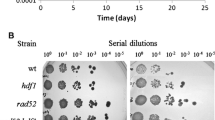Summary
Pedigree analyses of individual yeast cells recovering from DNA damage were performed and time intervals between morphological landmark events during the cell cycle (bud emergence and cell separation), were recorded for three generations. The associated nuclear behavior was monitored with the aid of DAPI staining. The following observations were made: (1) All agents tested (X-rays, MMS, EMS, MNNG, nitrous acid) delayed the first bud emergence after treatment, which indicates inhibition of the initiation of DNA replication. (2) Cells that survived X-irradiation progressed further through the cell cycle in a similar way to control cells. (3) Progress of chemically treated cells became extremely asynchronous because surviving cells stayed undivided for periods of varying length. (4) Prolongation of the time between bud emergence and cell separation was most pronounced for cells treated with the alkylating agents MMS and EMS. This is interpreted as retardation of ongoing DNA synthesis by persisting DNA adducts. (5) Cell cycle prolongation in the second and third generation after treatment was observed only with MMS treated cells. (6) In all experiments, individual cells of uniformly treated populations exhibited highly variable responses.
Similar content being viewed by others
Abbreviations
- DAPI:
-
4,6-diamidino-2-phenyl-indole
- EMS:
-
ethyl methanesulfonate
- MMS:
-
methyl methanesulfonate
- MNNG:
-
N-methyl-N′-nitro-N-nitrosoguanidine
References
Brendel M, Khan NA, Haynes RH (1970) Common steps in the repair of alkylation and radiation damage in yeast. Mol Gen Genet 106:289–295
Brewer BJ, Chlebowicz-Sledziewska E, Fangman WL (1984) Cell cycle phases in the unequal mother/daughter cell cycles of Saccharomyces cerevisiae. Mol Cell Biol 4:2529–2531
Drake JW, Baltz RH (1976) The biochemistry of mutagenesis. Annu Rev Biochem 45:11–37
Eggenberger E (1985) Graphische Datenanalyse. Anwendungen in der Tiermedizin. Habilitationsschrift, Universität Zürich
Fabre F, Roman H (1977) Genetic evidence for inducibility of recombination competence in yeast. Proc Natl Acad Sci USA 74:1667–1671
Fernandez A, Mondal S, Heidelberger C (1980) Probabilistic view of the transformation of cultured C3H/10T1/2 mouse embryo fibroblasts by 3-methylcholanthrene. Proc Natl Acad Sci USA 77:7272–7276
Hartwell LH (1971) Genetic control of the cell division cycle in yeast II. Genes controlling DNA replication and its initiation. J Mol Biol 59:183–194
Haynes RH, Kunz BA (1981) DNA repair and mutagenesis in yeast. In: Strathern JN, Jones EW, Broach JR (eds) The molecular biology of the yeast Saccharomyces. Cold Spring Harbor Laboratory, Cold Spring Harbor, NY, pp 371–414
Holm C (1982) Clonal lethality caused by the yeast plasmid 2 μ DNA. Cell 29:585–594
Kennedy AR, Fox M, Murphy G, Little JB (1980) Relationship between X-ray exposure and malignant transformation in C3H 10T1/2 cells. Proc Natl Acad Sci USA 77:7262–7266
Kennedy AR, Cairns J, Little JB (1984) Timing of the steps in transformation of C3H 10T1/2 cells by X-irradiation. Nature 307:85–86
Kupiec M, Simchen G (1985) Arrest of the mitotic cell cycle and of meiosis in Saccharomyces cerevisiae by MMS. Mol Gen Genet 201:558–564
Lindahl T (1979) DNA glycosylases, endonucleases for apurinic/apyrimidinic sites, and base excision-repair. Prog Nucleic Acid Res Mol Biol 22:135–192
Lord PG, Wheals AE (1983) Rate of cell cycle initiation of yeast cells when cell size is not a rate-determining factor. J Cell Sci 59:183–201
Mackay V, Manney TR (1974) Mutations affecting sexual conjugation and related processes in Saccharomyces cerevisiae. I. Isolation and phenotypic characterization of nonmating mutants. Genetics 76:255–271
McNeil DR (1977) Interactive Data Analysis. Wiley, New York
Painter RB, Young BR (1980) Radiosensitivity in ataxia-telangiectasia: A new explanation. Proc Natl Acad Sci USA 77:7315–7317
Prakash L (1976) Effect of genes controlling radiation sensitivity on chemically induced mutations in Saccharomyces cerevisiae. Genetics 83:285–301
Pringle JR, Hartwell LH (1981) The Saccharomyces cerevisiae cell cycle. In: Strathern JN, Jones EW, Broach JR (eds) The molecular biology of the yeast Saccharomyces. Cold Spring Harbor Laboratory, Cold Spring Harbor, NY, pp 97–142
Richmond KMV, Williamson DH (1983) Residual cell division measurements are unreliable as indicators of the timing of events in the Saccharomyces cerevisiae cell cycle. J Cell Sci 64:307–322
Rivin CJ, Fangman WL (1980) Cell cycle phase expansion in nitrogen-limited cultures of Saccharomyces cerevisiae. J Cell Biol 85:96–107
Saffhill R, Margison GP, O Connor PJ (1985) Mechanisms of carcinogenesis induced by alkylating agents. Biochim Biophys Acta 823:111–145
Schiestl R, Wintersberger U (1982) X-Ray enhances mating type switching in heterothallic strains of Saccharomyces cerevisiae. Mol Gen Genet 186:512–517
Schiestl R, Wintersberger U (1983) Induction of mating type interconversion in a heterothallic strain of Saccharomyces cerevisiae by DNA damaging agents. Mol Gen Genet 191:59–65
Sega GA (1984) A review of the genetic effects of ethyl methanesulfonate Mutat Res 134:113–142
Singer RA, Johnston GC (1981) Nature of the G1 phase of the yeast Saccharomyces cerevisiae. Proc Natl Acad Sci USA 78:3030–3033
Singer RA, Johnston GC (1983) Growth and the cell cycle of the yeast Saccharomyces cerevisiae II. Relief of cell-cycle constrains allows accelerated cell divisions. Exp Cell Res 149:15–26
Singer RA, Johnston GC (1985) Growth and the DNA-division sequence in the yeast Saccharomyces cerevisiae. Exp Cell Res 157:387–396
Tukey JW (1977) Exploratory data analysis. Addison-Wesley, Reading, MA
Waters R, Parry JM (1973) The response to chemical mutagens of the individual haploid and homoallelic diploid UV-sensitive mutants of the rad 3 locus of Saccharomyces cerevisiae. Mol Gen Genet 124:135–143
Wintersberger U (1982) Chemical carcinogenesis — the price for DNA-repair? Naturwissenschaften 69:107–113
Wintersberger U (1984) The selective advantage of cancer cells, a consequence of genome mobilization in the course of the induction of DNA-repair processes? Adv Enzyme Regul 22:311–323
Wintersberger U, Klein F (1987) Yeast mating type switching —a model system for the study of genome rearrangements induced by carcinogenes. Ann NY acad Sci (in press)
Author information
Authors and Affiliations
Additional information
Communicated by B.J. Kilbey
Rights and permissions
About this article
Cite this article
Wintersberger, U., Karwan, A. Retardation of cell cycle progression in yeast cells recovering from DNA damage: A study at the single cell level. Mol Gen Genet 207, 320–327 (1987). https://doi.org/10.1007/BF00331596
Received:
Issue Date:
DOI: https://doi.org/10.1007/BF00331596




